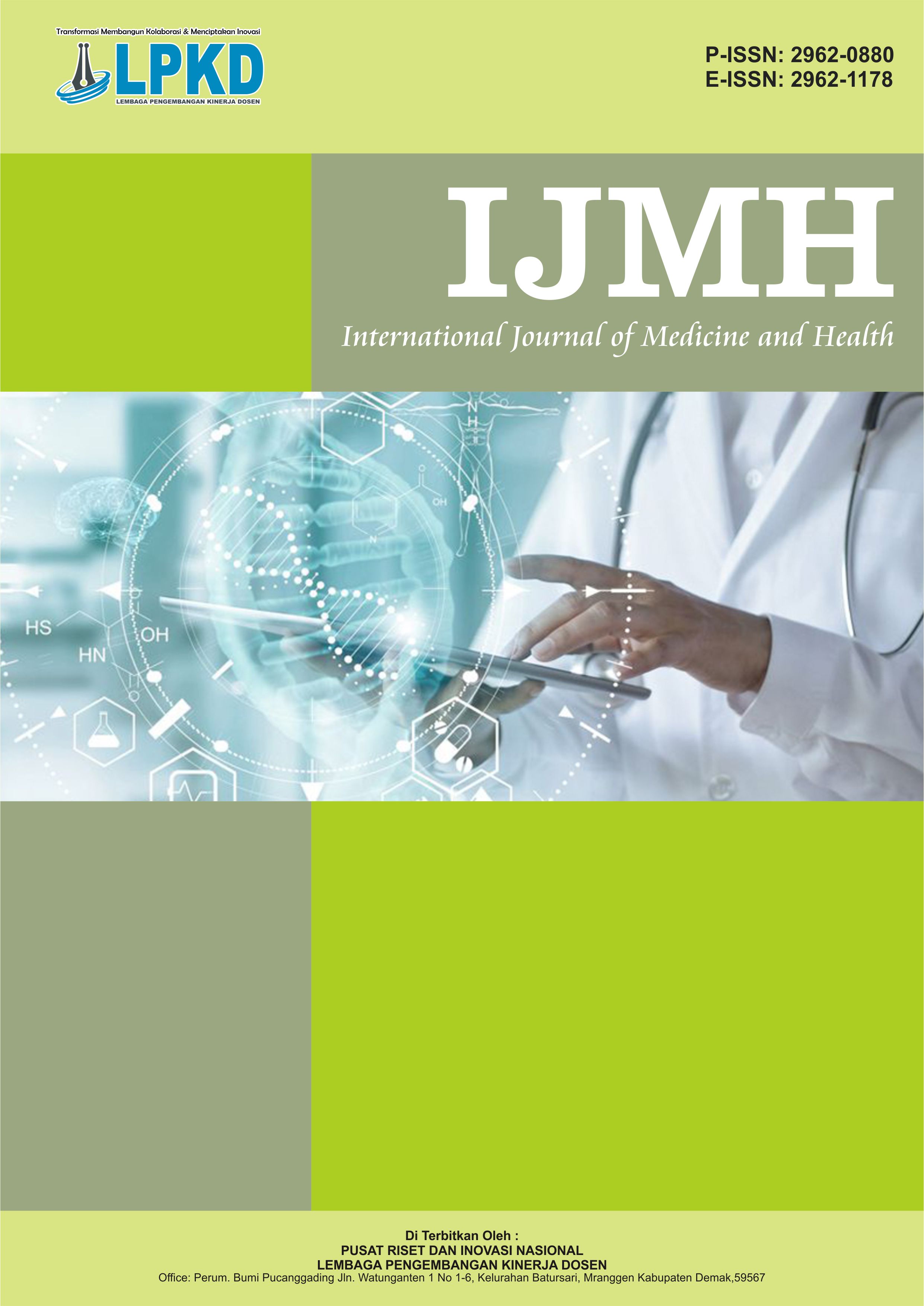The Relationship Between Family Support and Anxiety in Primigravida Pregnant Women in the Third Trimester
DOI:
https://doi.org/10.55606/ijmh.v1i4.4432Keywords:
Family support, anxiety level, pregnancyAbstract
Family support is assistance that can be given to other families in the form of goods, services, information, and advice which makes the recipient of support feel loved and appreciated. In this case, family support will bring a sense of joy, security, satisfaction, and comfort that makes pregnant women feel emotionally supported which will affect their mental well-being. Objective: This study aims to determine the relationship between family support and anxiety in Primigravida pregnant women in the third trimester in the work area of the Simeulue Tengah Health Center UPTD, Simeulue Regency. Method: This research method is an analytical survey with a cross-sectional approach with a sample size of 36 respondents using the total sampling technique. The study began on December 16-20, 2022. Results: Family support is in the sufficient category with 16 respondents (44.4%) and the level of anxiety in Primigravida pregnant women in the third trimester is in the moderate and severe categories, each with 12 respondents (33.3%). Conclusion: Based on the results of the study, it was found that there was a relationship between family support and anxiety levels in Primigravida pregnant women in the third trimester at the UPTD Simeulue Tengah Health Center, Simeulue Regency with a p-value = 0.043. Suggestion: It is hoped that medical personnel at the Health Center can provide counseling to families who have pregnant women.
References
Abdullah, M. (2015). Method study quantitative. http://idr.uinantasari.ac.id/5014/1/Researcher_Methodology_Administration_SR-JI_&_2018_undefined.pdf
Administrationstisip, E-Journal. (2018). Analysis of community preparedness in flood-prone areas (Study in Paruga Village, West Rasanae District City, Bima). Administrationstisip E-journal, 15(2), 2085–1804. http://administrasistisip.ejournal.web.id/index.php/administrasistisip/article/view/143ian_Quantitative.pdf
Bandura, A. (1983). Self-efficacy: Determinants of anticipated fears and calamities. Journal of Personality and Social Psychology, 45(2), 464–469. https://psycnet.apa.org/record/1984-06766-001
Cohen, J. W. (1988). Statistical power analysis for behavioral sciences (2nd ed.). Lawrence Erlbaum Associates.
Creswell, J. W. (1994). Research design: Qualitative and quantitative approaches. Sage.
Eisenhardt, K. M., & Martin, J. A. (2000). Dynamic capabilities: What are they? Strategic Management Journal, 21, 1105–1121.
Ekah, U. J., & Iloke, J. (2022). Performance evaluation of key performance indicators for UMTS networks in Calabar, Nigeria. GSC Advanced Research and Reviews, 10(1), 47–52.
Ezenwakwelu, C. A., Akpan, E. E., & Ogbogu-Asogwa, O. I. (2021). Enabling service innovation through dynamic capabilities: Insight from telecommunication firms. International Journal of Business and Management Invention, 10(5), 54–63.
Fincham, J. (2008). Response rates and responsiveness for surveys, standards, and the journal. American Journal of Pharmaceutical Education, 72(2), 1–3.
Herdwiyanti, F., & Sudaryono. (2012). Differences in preparedness for facing disasters reviewed from the level of self-efficacy in elementary school children in the Mount Kelud disaster impact area. Journal of Personality and Social Psychology, 1(03), 136–141. http://journal.unair.ac.id/download-fullpapers-jpks957e6ca3132full.pdf
Jayanti, R. D. (2020). Self-efficacy in SMP earthquake disaster preparedness boarding school and junior high school M 21 Gantiwarno. JPIG: Journal of Education and Geographical Sciences, 5(1), 46–55. https://doi.org/10.21067/jpig.v5i1.4012
Kamilah, S. F. (2015). The influence of self-efficacy, social support, and empathy on motivation to teach special needs teachers in South Jakarta (Thesis). Faculty of Psychology, Syarif Hidayatullah State Islamic University, Jakarta, 5(1), 121.
Kelud, D. (2013). Differences in disaster preparedness reviewed from the level of self-efficacy in elementary school age children. Journal, Unair.ac.id, 2(01). http://www.journal.unair.ac.id/filerPDF/110810003_ringkasan.pdf
Kurniasari, N., Handling, S., & Tourism, K. (2017). Crisis management strategy in tourism and the National Disaster Management Agency (BNPB) policy.
Leaning, J., & Guha-Sapir, D. (2013). Natural disasters, armed conflict, and public health. New England Journal of Medicine, 369(19), 1836–1842. https://doi.org/10.1056/NEJMRA1109877
LIPI-UNESCO/ISDR. (2006). Study of community preparedness in anticipating disasters: Landslide and tsunami disasters. Jakarta: Deputy for Earth Sciences, Indonesian Institute of Sciences.
Mahdia, F., & Noviyanto, F. (2013). Post-transportation logistics assistance management information system mobile web-based natural disaster management (case study: Yogyakarta City Regional Disaster Management Agency). https://www.neliti.com/publications/211271/pecepatangoogle-maps-api-untuk-pembangunan-sistem-information-manajemen-bangunan
March, B. B.-E., & U. (2013). Disaster info. BNPB.go.id, 5(1). https://bnpb.go.id/uploads/publication/1094/BENCANA_INFO_JAN_2015_DIGITAL3-FEB.pdf
Maryanti, S., Lestari, E., Putri, W., Wardani, A. R., & Haris, F. (2017). Relationship between the level of public education on landslide disaster preparedness in Giritirto Village, Wonogiri District. Seminar Proceedings.
Mastura, M. (2015). The relationship between self-efficacy and earthquake disaster preparedness and tsunami on students of State Senior High Schools 2 and 6 Banda Aceh. Idea Nursing Journal, 6(2), 53–61.
National Geography UMS. (2017). 319–330. http://publikasiilmiah.ums.ac.id/handle/11617/9019
Permadi, M. G., Tjahjono, B., & Baskoro, D. P. T. (2018). Identification of risk areas for landslide disaster in Bogor City. Journal of Soil and Environmental Science, 20(2), 86–94. https://doi.org/10.29244/JITL.20.2.86-94
Undiksha Geography Education, 8(1), 43–54. https://doi.org/10.23887/jjpg.v8i1.23477
Downloads
Published
Issue
Section
License
Copyright (c) 2024 International Journal of Medicine and Health

This work is licensed under a Creative Commons Attribution-ShareAlike 4.0 International License.






